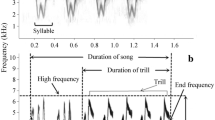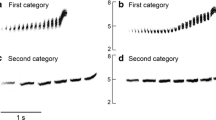Abstract
Stochastic dynamic programming (SDP) models predict that males singing to attract a mate should concentrate singing in what has been termed the dawn chorus. This is because male birds should have a variable surplus of fat in the morning that can be used to fuel singing, with the amount of fat available dependent upon such factors as his quality, foraging success and risk of predation. In this manner, the dawn chorus can act as an indicator of male quality in the context of female mate choice. We test a key prediction of SDP models of singing behaviour that males with greater fat levels should sing more. We conducted an experiment where we recorded the dawn chorus of male silvereyes (Zosterops lateralis) on three consecutive days. Each male received supplementary food on the second day, which enabled us to sample his dawn chorus before, during and after food supplementation. We also collected data on the effect of supplementary food on the body mass of silvereyes. As predicted by SDP models, we found that silvereyes sang for a greater proportion of the time after receiving supplementary food. Supplementary food also had a significant effect on the complexity of a male song, indicating that males not only increased the quantity of their song but also the quality of their song when they received extra food. As the provision of supplementary food significantly increased the mass of fed birds, our results support a causal link between male energy reserves and his ability to perform the dawn chorus.



Similar content being viewed by others
References
Berg MJ, Beitenna NH, Welbergen JA, Komduer J (2005) Singing as a handicap: the effect of food availability and weather on song output in the Australian reed warbler Acrocephalus australis. J Avian Biol 36:102–109
Buchanan KL, Catchpole CK (2000) Song as an indicator of male parental effort in the sedge warbler. Proc R Soc Lond B 267:321–326
Buchanan KL, Catchpole CK, Lewis JW, Lodge A (1999) Song as an indicator of parasitism in the sedge warbler. Anim Behav 57:307–314
Catchpole CK, Slater PJB (1995) Bird song: biological themes and variations. Cambridge University Press, Cambridge
Catterall CP, Kikkawa J, Gray C (1989) Inter-related age-dependent patterns of ecology and behaviour in a population of silvereyes (Aves: Zosteropidae). J Anim Ecol 58:557–570
Collins S (2004) Vocal fighting and flirting: the functions of birdsong. In: Marler P, Slabbekoorn H (eds) Nature’s music: the science of birdsong. Academic, San Diego, pp 39–79
Cucco M, Malacarne G (1997) The effects of supplemental food on time budget and body condition in the black redstart Phoenicurus ochruros. Ardea 85:211–221
Cuthill IC, Macdonald WA (1990) Experimental manipulation of the dawn and dusk chorus in the blackbird Turdus merula. Behav Ecol Sociobiol 26:209–216
Eberhardt LS (1994) Oxygen consumption during singing by male Carolina wrens (Thryothorus ludovicianus). Auk 111:124–130
Garson PJ, Hunter ML (1979) Effect of temperature and time of year on the singing behaviour of wrens (Troglodytes troglodytes) and great tits (Parus major). Ibis 121:481–487
Godfrey JD, Bryant DM (2000) State-dependent behaviour and energy expenditure: an experimental study of European robins on winter territories. J Anim Ecol 69:301–313
Gosler AG (1996) Environmental and social determinants of winter fat storage in the great tit Parus major. J Anim Ecol 65:1–17
Gottlander K (1987) Variation in the song rate of the male pied flycatcher Ficedula hypoleuca: causes and consequences. Anim Behav 35:1037–1043
Greig-Smith PW (1982) Song-rates and parental care by individual male stonechats (Saxicola torquata). Anim Behav 30:245–252
Houston AI, McNamara JM (1987) Singing to attract a mate: a stochastic dynamic game. J Theor Biol 129:57–68
Hutchinson JM, McNamara JM (2000) Ways to test stochastic dynamic programming models empirically. Anim Behav 59:665–676
Hutchinson JMC, McNamara JM, Cuthill IC (1993) Song, sexual selection, starvation and strategic handicaps. Anim Behav 45:1153–1177
Ince SA, Slater PJB (1985) Versatility and continuity in the songs of thrushes Turdus spp. Ibis 127:355–364
Lambrechts MM (1996) Organisation of birdsong and constraints on performance. In: Kroodsma DA, Miller EH (eds) Ecology and evolution of acoustic communication in birds. Cornell University Press, Ithaca, pp 426–453
Lucas JR, Schraeder A, Jackson C (1999) Carolina chickadee (Aves, Paridae, Poecile carolinensis) vocalisation rates: effects of body mass and food availability under aviary conditions. Ethology 105:503–520
Mace R (1987) Why do birds sing at dawn? Ardea 75:123–132
Mace RH (1989) The relationship between daily routines of singing and foraging: an experiment on captive great tits Parus major. Ibis 131:415–420
Maddocks TA, Geiser F (2000) Seasonal variations in thermal energetics of Australian silvereyes (Zosterops lateralis). J Zool Lond 252:327–333
Maddocks TA, Goller F (1997) Energetics, thermoregulation and nocturnal hypothermia in Australian silvereyes. Condor 99:104–111
Martin P, Bateson P (1993) Measuring behaviour: an introductory guide, 2nd edn. Cambridge University Press, Cambridge
McNamara JM, Mace RH, Houston AI (1987) Optimal daily routines of singing and foraging in a bird singing to attract a mate. Behav Ecol Sociobiol 20:399–405
Oberweger K, Goller F (2001) The metabolic cost of birdsong production. J Exp Biol 204:3379–3388
Reid M (1987) Costliness and the reliability of singing vigour as an indicator of fitness in the Ipswich sparrow. Anim Behav 35:1735–1743
Robertson BC, Degnan SM, Kikkawa J, Moritz C (2001) Genetic monogamy in the absence of paternity guards: the Capricorn silvereye, Zosterops lateralis chlorocephalus, on Heron Island. Behav Ecol 6:666–673
Searcy WA (1979) Sexual selection and body size in red-winged blackbirds. Evolution 33:649–661
Searcy WA, Yasakawa K (1996) Song and female choice. In: Kroodsma DA, Miller EH (eds) Ecology and evolution of acoustic communication in birds. Cornell University Press, Ithaca, pp 454–473
Shackleton SA, Ratcliffe L (1994) Matched counter-singing signals escalation of aggression in black-capped chickadees (Parus atricapillus). Ethology 97:310–316
Slater PJ (1993) The relationship between individual variation in song and ecology in the Capricorn silvereye. Emu 93:145–155
Staicer CA, Spector DA, Horn AG (1996) The dawn chorus and other diel patterns in acoustic signalling. In: Kroodsma DA, Miller EH (eds) Ecology and evolution of acoustic communication in birds. Cornell University Press, Ithaca, pp 426–453
Strain JG, Mumme RL (1988) Effects of food supplementation, song playback, and temperature on vocal and territorial behavior of Carolina wrens. Auk 105:11–16
Suthers RA, Goller F (1997) Motor correlates of vocal diversity in songbirds. Curr Ornithol 14:235–288
Thomas RJ (1999) Two tests of a stochastic dynamic programming model of daily singing routines in birds. Anim Behav 57:277–284
Thomas RJ, Cuthill IC (2002) Body mass regulation and the daily singing daily singing routines of European robins. Anim Behav 63:285–292
Ward S, Speakman JR, Slater PJB (2003) The energy cost of song in the canary, Serinus canaria. Anim Behav 66:893–902
Wiley RH, Richards DG (1982) Adaptations for acoustic communication in birds: sound transmission and signal detection. In: Kroodsma DE, Miller EH (eds) Acoustic communication in birds, vol 1. Academic, New York, pp 131–181
Ydenberg RC (1984) The conflict between feeding and territory defence in the great tit. Behav Ecol Sociobiol 15:103–108
Zar JH (1996) Biostatistical analysis, 3rd edn. Prentice-Hall, Upper Saddle River
Acknowledgements
We thank Jack van Berkel at the Edward Percival Field Station in Kaikoura for providing facilities during our field work in the area. We were permitted to work at Kowhai Bush by the Canterbury Regional Council. This study was approved by the Animal Ethics Committee of the University of Canterbury and the New Zealand Department of Conservation. Funding was provided by the School of Biological Sciences at the University of Canterbury, New Zealand.
Author information
Authors and Affiliations
Corresponding author
Additional information
Communicated by P. Heeb
Rights and permissions
About this article
Cite this article
Barnett, C.A., Briskie, J.V. Energetic state and the performance of dawn chorus in silvereyes (Zosterops lateralis). Behav Ecol Sociobiol 61, 579–587 (2007). https://doi.org/10.1007/s00265-006-0286-x
Received:
Revised:
Accepted:
Published:
Issue Date:
DOI: https://doi.org/10.1007/s00265-006-0286-x




